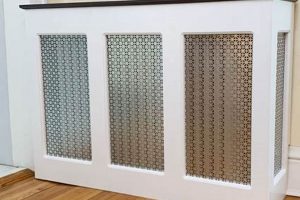The construction of floral arrangements from crafted paper elements presents an opportunity for personalized artistry. This method involves the meticulous cutting, shaping, and assembly of paper to replicate the aesthetic qualities of natural blossoms and foliage. The resulting collection of paper flora is then organized and secured to form a cohesive and visually appealing display, intended as a substitute for conventional bouquets.
Creating such arrangements offers several advantages, including cost-effectiveness, longevity, and the potential for complete customization. Unlike fresh flowers, paper alternatives do not wilt or require water, providing a lasting decorative element. Furthermore, the process allows for control over color, size, and style, enabling the creation of unique pieces tailored to specific preferences or occasions. Historically, the creation of artificial flowers has been practiced across cultures, evolving from simple craft to sophisticated art forms.
The subsequent sections will delve into specific techniques for crafting individual paper flowers, assembling these elements into a unified bouquet, and exploring diverse design possibilities. Materials, tools, and step-by-step instructions will be detailed to facilitate the successful execution of these projects, leading to impressive and enduring handcrafted floral displays.
Essential Considerations for Paper Floral Artistry
Effective creation of paper floral arrangements necessitates careful planning and execution. Attention to detail throughout the process ensures a professional and visually satisfying outcome.
Tip 1: Material Selection: Opt for paper types that complement the intended flower species. Crepe paper provides flexibility and texture for realistic petals, while cardstock offers durability for structural components. The weight and finish of the paper should align with the desired aesthetic.
Tip 2: Accurate Templates: Utilize precise templates for petal and leaf shapes. Inaccurate patterns can result in misshapen flowers and an unprofessional appearance. Online resources and pattern books provide a wealth of templates, or unique designs can be created through careful drafting.
Tip 3: Controlled Adhesive Application: Employ adhesive sparingly and strategically. Excessive glue can distort the paper and create unsightly blemishes. Glue dots or a low-temperature glue gun offer controlled application for delicate paper surfaces.
Tip 4: Gradual Assembly: Assemble flowers in stages, allowing adhesive to dry completely between layers. Rushing the assembly process can lead to instability and structural weakness in the finished product. Patience is essential for a robust and well-formed bloom.
Tip 5: Realistic Shaping: Manipulate petals and leaves to emulate the natural curvature and texture of real flowers. Utilize tools such as bone folders or embossing styluses to create subtle folds and bends that enhance the lifelike quality of the arrangement.
Tip 6: Secure Stem Attachment: Ensure that stems are securely attached to the flower heads. Floral wire or strong adhesive can be used to reinforce the connection and prevent separation. The stability of the stem is crucial for the overall presentation of the bouquet.
Tip 7: Arrangement Balance: Consider the overall balance and composition of the bouquet. Distribute different flower types and colors evenly to create a harmonious and visually appealing arrangement. Experiment with varying heights and textures to add depth and dimension.
Mastery of these techniques translates into the creation of enduring and elegant paper floral displays. Attention to detail and adherence to best practices contribute to both the aesthetic appeal and structural integrity of the finished work.
The subsequent section will explore specific floral designs, building upon these foundational tips to achieve more complex and nuanced artistry.
1. Paper Selection
The selection of appropriate paper directly influences the final aesthetic and structural integrity of a handcrafted floral arrangement. This critical choice determines the flower’s texture, color saturation, and ability to maintain its form. A paper too thin may lack the necessary support, resulting in wilting or tearing, while a paper too thick might prove difficult to manipulate into the desired shapes. For instance, crepe paper, known for its stretch and texture, is often preferred for petals requiring a delicate, organic appearance. Conversely, heavier cardstock might be utilized for the base or calyx of the flower to provide stability and support.
The color and finish of the paper also play a crucial role. Subtle gradients and variations in color can mimic the natural hues of real flowers, enhancing the realism of the arrangement. Different finishes, such as matte or gloss, can impart distinct characteristics to the petals, affecting how they reflect light and contribute to the overall visual impact. Consider the example of a rose, where varying shades of red and pink, combined with a slight sheen, can create a sense of depth and volume. Conversely, a paper flower intended to evoke a vintage aesthetic might benefit from a muted color palette and a matte finish.
Ultimately, informed paper selection is paramount to a successful outcome. The interplay between paper type, weight, color, and finish determines the longevity and beauty of the paper floral creations. A failure to consider these factors can result in arrangements that lack visual appeal or structural integrity. By carefully evaluating the requirements of each individual flower and the overall design of the bouquet, one can ensure a result that reflects skillful craftsmanship and thoughtful planning, creating a delightful hand crafted floral display.
2. Template Accuracy
The success of a paper floral arrangement is intrinsically linked to the precision of the templates employed. Inaccurate templates produce misshapen petals and leaves, disrupting the intended aesthetic and ultimately undermining the overall quality of the bouquet. Every petal and leaf serves as a building block; consistent deviations from the ideal form compound throughout the assembly process, resulting in a final product that lacks the elegance and realism achievable with accurately rendered components. The initial investment in creating or acquiring precise templates provides a foundation for consistent and satisfying results.
Consider the creation of a paper rose. A template set containing consistently sized and shaped petals allows for the creation of a symmetrical and visually appealing bloom. In contrast, if the templates are flawed, resulting in petals that vary in size or shape, the rose will appear unbalanced and amateurish. The same principle applies across a wide variety of floral designs, from the simple daisy to the complex peony. Furthermore, accurate templates facilitate e
fficient production, reducing material waste and minimizing the need for corrections during assembly. Precise patterns obtained from reputable sources, or meticulously drafted originals, streamline the crafting process.
In summary, template accuracy constitutes a non-negotiable element in crafting aesthetically pleasing paper floral arrangements. The use of precise templates translates directly into improved aesthetic outcomes, efficient production, and reduced material waste. The careful selection and utilization of accurate templates represents a crucial step toward realizing the full potential of creating custom floral art, emphasizing the significance of meticulous preparation within the wider crafting practice.
3. Adhesive Control
Adhesive control is paramount in crafting enduring and aesthetically pleasing paper floral arrangements. Its mastery directly influences the structural integrity, visual appeal, and overall longevity of the finished product. Improper adhesive application can lead to unsightly blemishes, distorted paper, and weakened bonds, detracting from the artistry and lifespan of the creation.
- Types of Adhesives
The selection of appropriate adhesive is the first step in adhesive control. Different adhesives offer varying strengths, drying times, and finishes. Hot glue provides a strong, rapid bond, suitable for securing stems and larger components, but its potential for visible residue necessitates careful application. Glue sticks offer a clean, matte finish, suitable for layering petals, but lack the strength for structural elements. Liquid adhesives provide versatility, but require precise application to prevent warping or staining. The appropriate adhesive balances strength, appearance, and handling characteristics.
- Application Techniques
The method of application is as critical as the choice of adhesive. Applying excessive adhesive can saturate and distort paper fibers, resulting in visible stains and compromised structural integrity. Conversely, insufficient adhesive results in weak bonds prone to separation. Techniques such as dotting, feathering, and edge gluing allow for precise control over adhesive distribution. Employing tools such as fine-tipped applicators or brushes facilitates targeted application in intricate areas, minimizing excess and ensuring uniform coverage. The selection of application methods should reflect the specific requirements of each joining task within the creation of a paper floral arrangement.
- Drying Time Management
Proper management of drying time is crucial for preventing misalignment and distortion during the assembly process. Premature manipulation of components before the adhesive has fully cured can result in shifting and compromised bond strength. Conversely, allowing adhesive to dry excessively before joining components hinders proper adhesion. Implementing strategies such as clamping, pinning, or weighting can maintain alignment during the drying period. Understanding the specific drying characteristics of the chosen adhesive and implementing appropriate stabilization techniques ensures secure and aesthetically pleasing joints.
- Residue Removal
The presence of visible adhesive residue detracts from the overall aesthetic of a paper floral arrangement. Preventing residue through controlled application techniques is preferable to attempting removal after the fact. However, in instances where residue is unavoidable, gentle cleaning methods may be employed. Using a soft cloth dampened with appropriate solvent can carefully remove excess adhesive without damaging the paper. The type of solvent should be carefully selected to avoid discoloration or degradation of the paper fibers. Employing preventative measures during application and implementing gentle cleaning techniques when necessary preserves the visual integrity of the finished arrangement.
These facets of adhesive control demonstrate its crucial role in the creation of durable and visually appealing paper floral arrangements. The conscious selection of appropriate adhesives, precise application techniques, attentive management of drying times, and proactive residue removal strategies contribute to crafting hand crafted floral displays.
4. Assembly Sequence
The systematic arrangement of components during the construction of paper floral creations is designated as the assembly sequence. This ordered progression governs the structural integrity, aesthetic appeal, and overall success of a hand crafted floral display. A well-defined assembly sequence mitigates the risk of structural weaknesses, ensures accurate replication of floral morphology, and streamlines the creation process.
- Base Construction
The creation of a stable base serves as the foundational step in most paper flower projects. This often involves crafting a central core or calyx to which individual petals are subsequently attached. The base provides structural support and defines the overall shape of the flower. For example, a tightly rolled paper cone or a small sphere formed from floral foam can serve as the central point for a rose, ensuring the petals are anchored securely and maintain the desired form. Neglecting this initial step can lead to instability and distortion of the finished flower.
- Petal Attachment
The sequence of petal attachment significantly impacts the realism and visual harmony of the flower. Typically, petals are applied in layers, starting with the innermost petals and progressing outwards. Overlapping petals in a specific pattern emulates the natural arrangement of real flowers. For instance, when constructing a paper peony, smaller, tightly curled petals are attached first to create the center, followed by larger, more open petals to form the outer layers. Deviations from this sequence can result in a flower that appears flat or lacks depth.
- Foliage Integration
The addition of leaves and other foliage elements enhances the realism and visual interest of the bouquet. Foliage is strategically incorporated to complement the flowers and provide a sense of natural context. The timing of foliage attachment is crucial; it is often best to attach leaves after the majority of the flowers have been assembled, allowing for adjustments to ensure proper balance and visual harmony. For example, adding long, slender leaves around the base of a bouquet can create a flowing effect and conceal any visible stems or structural elements.
- Stem Securing and Arrangement
The final stage involves securing the individual flowers to stems and arranging them into a cohesive bouquet. Stems are typically made from floral wire or wooden dowels, providing support and allowing for manipulation of the flower’s position. The order in which flowers are attached to the stems and the arrangement within the bouquet dictates the overall composition. Attention to color balance, flower spacing, and overall symmetry ensures a visually appealing and balanced arrangement. Securing flowers at varying heights and angles creates depth and dimension, mimicking the natural asymmetry of real bouquets.
Adherence to a logical and well-defined assembly sequence is indispensable for crafting paper floral arrangements that exhibit both aesthetic appeal and structural integrity. The ordered progression from base construction
to petal attachment, foliage integration, and stem securing ensures a final product that effectively replicates the beauty and artistry of natural floral displays. The ability to create a realistic hand crafted floral displays.
5. Shaping Techniques
The creation of visually compelling floral arrangements through the medium of paper relies heavily on the application of various shaping techniques. These methods are essential for transforming flat sheets of paper into three-dimensional representations of botanical forms, imparting a sense of realism and artistry to the finished bouquet. The effectiveness of these techniques directly impacts the overall aesthetic quality of the arrangement.
- Curling and Rolling
Curling and rolling are fundamental techniques for adding dimension and curvature to paper petals and leaves. These methods typically involve using tools such as wooden dowels, skewers, or specialized curling tools to manipulate the paper fibers. The degree of pressure and the angle of application determine the tightness of the curl or roll. For instance, tightly curled paper can be used to create the inner petals of a rose, while loosely rolled paper can form the delicate petals of a poppy. The precision and consistency of curling and rolling significantly contribute to the overall realism of the floral arrangement.
- Scoring and Folding
Scoring and folding are used to create crisp lines and defined edges, adding structural integrity and visual interest to paper flowers. Scoring involves creating a shallow crease in the paper, facilitating a clean and precise fold. Folding techniques, such as accordion folding or origami-inspired folds, can be used to create intricate petal shapes or to add texture and dimension to leaves. The sharpness of the fold and the accuracy of the scoring directly impact the final appearance of the paper flower, influencing its overall form and aesthetic appeal.
- Embossing and Texturing
Embossing and texturing techniques enhance the tactile and visual qualities of paper petals and leaves, adding depth and realism to paper floral arrangements. Embossing involves creating raised patterns on the paper surface using specialized tools or embossing machines. Texturing techniques, such as crumpling, stippling, or applying textured paints, can mimic the natural surfaces of real flowers and foliage. The subtle variations in texture and the added dimension created through embossing contribute to the lifelike appearance of the finished arrangement.
- Stretching and Shaping
Stretching and shaping techniques involve manipulating the paper fibers to create organic curves and realistic forms. These methods typically require a delicate touch and a keen understanding of the paper’s properties. Stretching crepe paper, for example, can create a natural-looking ruffle or wave in a petal. Shaping techniques, such as gently cupping the petals with fingertips or using specialized shaping tools, can impart a sense of depth and volume to the paper flower. The skillful application of stretching and shaping techniques is essential for achieving a natural and visually appealing result.
The strategic and skillful employment of these shaping techniques is central to crafting convincing paper floral displays. The combined effect of curling, scoring, embossing, and stretching transforms ordinary paper into a medium capable of expressing intricate botanical forms, resulting in elegant, enduring hand crafted floral displays.
6. Stem Attachment
Stem attachment, within the context of creating paper floral arrangements, directly impacts the structural integrity and aesthetic presentation of the finished piece. The connection between the flower head and the stem serves as the crucial point of support, dictating the flower’s ability to maintain its upright posture and withstand handling. A poorly executed stem attachment results in drooping flowers, instability within the arrangement, and an overall diminished visual impact. For example, a large paper peony head inadequately affixed to a thin wire stem will inevitably droop, compromising the flower’s intended elegant form and the aesthetic balance of the bouquet. Thus, stem attachment represents a crucial structural phase of any paper floral art.
The selection of appropriate materials and techniques significantly influences the success of stem attachment. Floral wire, wooden dowels, or even repurposed materials such as sturdy paper straws can serve as viable stem options, each offering varying degrees of support and aesthetic qualities. The chosen adhesive, whether hot glue, floral tape, or specialized craft glue, must establish a secure and lasting bond between the flower head and the stem material. Reinforcement methods, such as wrapping the stem attachment point with floral tape or strategically embedding the stem within the flower’s base, provide additional stability and prevent separation. Moreover, the angle of the stem attachment influences the flower’s orientation within the bouquet, affecting the overall flow and visual harmony of the arrangement. A consistent, slightly angled stem attachment, for instance, can create a sense of natural movement and prevent a static or artificial appearance. A variety of commercial and domestic glues must be appropriately chosen.
In conclusion, stem attachment forms a vital, yet often overlooked, aspect of constructing paper floral bouquets. Its effectiveness directly correlates with the longevity, stability, and visual appeal of the arrangement. Mastery of appropriate techniques, combined with careful material selection and attention to detail, is essential for achieving professional-quality results. Any shortcomings in stem attachment undermine the effort invested in crafting the individual flowers, ultimately detracting from the overall impact of the finished product. The structural needs and resulting impact of improper stem attachment must be considered with the design.
7. Arrangement Balance
Achieving balance in paper floral displays is paramount to creating aesthetically pleasing and visually harmonious compositions. Arrangement balance encompasses a spectrum of considerations that influence the perceived stability, visual weight, and overall impact of the bouquet. Careful attention to these elements elevates the finished creation from a mere collection of paper flowers to a sophisticated and artful representation of nature.
- Symmetry and Asymmetry
Symmetry, characterized by mirrored elements on either side of a central axis, conveys a sense of formality and order. Asymmetry, conversely, achieves balance through the strategic placement of differing elements to create visual equilibrium. While symmetrical arrangements may appeal to those seeking a classic aesthetic, asymmetrical designs often emulate the organic randomness found in natural floral arrangements, resulting in a more dynamic and visually engaging piece. The choice between symmetry and asymmetry in a paper floral bouquet dictates the overall tone and visual complexity of the composition.
- Color Distribution
The strategic distribution of color plays a cri
tical role in achieving arrangement balance. Dominant colors can create focal points and establish a visual hierarchy, while supporting colors provide contrast and depth. Uneven distribution of strong colors can create imbalance, drawing the eye disproportionately to one area of the bouquet. Employing a balanced color palette ensures a harmonious and visually cohesive arrangement. For instance, a bouquet featuring a cluster of vibrant red paper roses offset by muted green foliage creates a balanced and visually appealing composition. - Textural Variety
Incorporating a variety of textures contributes to the overall visual interest and balance of a paper floral arrangement. Smooth, delicate petals can be juxtaposed with textured leaves or rougher paper elements to create contrast and depth. Monotony in texture can lead to a flat and uninspired arrangement. The strategic placement of differing textures draws the eye and adds complexity to the composition. For example, incorporating crepe paper roses alongside textured cardstock leaves provides a tactile and visually engaging contrast.
- Focal Point Placement
Establishing a clear focal point is essential for guiding the viewer’s eye and creating a sense of visual balance. The focal point typically features the largest or most visually striking flower in the arrangement, strategically positioned to draw attention and anchor the composition. Surrounding elements should complement and support the focal point without competing for attention. Proper focal point placement creates a sense of visual hierarchy and ensures a balanced and engaging arrangement.
The careful consideration of symmetry, color distribution, textural variety, and focal point placement allows for the creation of balanced and visually compelling paper floral bouquets. These elements work in concert to elevate the finished creation, transforming a collection of crafted paper flowers into a sophisticated and harmonious artistic expression, demonstrating a grasp of aesthetic and structural design.
Frequently Asked Questions
The following addresses common inquiries and concerns regarding the creation of hand crafted floral displays using paper.
Question 1: What types of paper are best suited for crafting realistic flower petals?
Crepe paper, due to its inherent stretch and texture, emulates the delicate nature of natural petals. Text weight paper offers versatility for various flower styles, while cardstock provides structural integrity for bases and larger blooms. The selection depends on the desired effect and the specific flower being replicated.
Question 2: Are specialized tools necessary for constructing paper floral arrangements, or can common household items suffice?
While specialized tools such as floral wire cutters, bone folders, and embossing styluses can enhance precision and efficiency, many tasks can be accomplished using household equivalents. Scissors, craft knives, and rounded implements for shaping can serve as acceptable substitutes, particularly for beginners.
Question 3: How can the longevity of a paper floral arrangement be maximized?
Protecting the finished arrangement from direct sunlight and moisture is crucial. Dust accumulation can be minimized by gentle cleaning with a soft brush. Storing the arrangement in a dry, climate-controlled environment further extends its lifespan.
Question 4: What adhesive types offer the most secure and aesthetically pleasing bonds in paper flower construction?
Low-temperature hot glue guns provide a strong, rapid bond suitable for securing stems and larger components. Glue sticks offer a clean, matte finish for layering petals. Liquid adhesives require precise application to prevent warping or staining. The selection depends on the materials being joined and the desired aesthetic.
Question 5: How can a paper floral arrangement be customized to reflect individual preferences or complement specific dcor styles?
Paper type, color palette, flower selection, and arrangement style all offer avenues for personalization. Incorporating unique embellishments, such as beads, ribbons, or painted accents, further enhances the customizability of the piece. These individual touches allow for the creation of a bespoke hand crafted floral display.
Question 6: Is prior crafting experience required to successfully create a paper floral bouquet?
While prior experience can be beneficial, basic crafting skills are generally sufficient for undertaking paper flower projects. Numerous tutorials and resources are available for beginners, providing step-by-step guidance and instruction. Patience and attention to detail are key to achieving satisfactory results.
These responses provide a foundation for understanding the nuances of paper floral arrangement. Careful consideration of these factors contributes to both the aesthetic appeal and structural integrity of the finished work.
The subsequent section will explore advanced techniques for creating complex and nuanced floral designs.
Conclusion
The preceding exploration of diy paper flower bouquet techniques underscores the potential for creating lasting and personalized floral art. From careful material selection to the nuanced application of shaping and assembly methods, the process necessitates precision and a commitment to detail. The creation of convincing paper floral arrangements involves mastering both foundational skills and advanced artistic strategies.
The enduring appeal of handcrafted botanical representations suggests continued innovation in this art form. Further exploration of materials, techniques, and design principles promises to yield increasingly sophisticated and realistic diy paper flower bouquet creations, enriching the landscape of decorative arts and offering a sustainable alternative to traditional floral displays. Therefore, continued refinement and creativity will ensure its ongoing evolution and appreciation.






![DIY Build: Circular Saw Crosscut Jig PDF Plans [Free] The DIY Hub: Creative Crafts, Repairs & Life Hacks DIY Build: Circular Saw Crosscut Jig PDF Plans [Free] | The DIY Hub: Creative Crafts, Repairs & Life Hacks](https://craftingdiycenter.com/wp-content/uploads/2025/07/th-5916-300x200.jpg)
